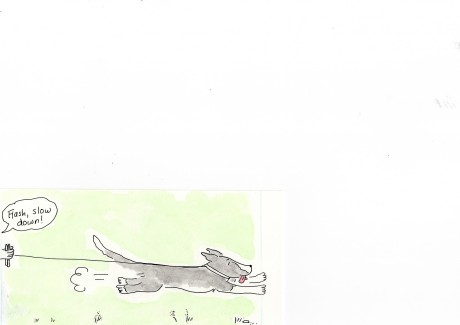Years ago, when Mother Knows Best first came out, one of my clients was looking through the book and when she came to a photograph where there was much to get about dog behavior, about how to interpret what you see, about how to relate to your dog and understand the way they attempt to relate to us, in a picture that just happened and that I couldn’t get again in a million years, she said, “I have the same boots!”
Long before that, I understood the power of drawing, the way it can focus the eye on what’s important and eliminate what isn’t, like the trainer’s very chic suede boots. Long before that, I knew I could draw dogs to show what they were feeling, show it in a way far less subtile than their real faces, their real eyes, were apt to show it. And that sometimes, after seeing the cartoon, pet owners could see that their real dog was feeling sad, mad, glad, or even bewildered, just like the dog I drew.
More and more, I saw that I could shine a light on the behavior of both human and dog by leaving things out of the picture, the cluttered background, the suede boots, even the trainer’s other hand, the one that wasn’t giving the signal I wanted the reader to see. I could even leave out the trainer altogether, except for his or her voice, and still get the point across.
As important, I wasn’t one of those trainers who made people cry in class or made fun of them as they tried their best to learn what I was teaching – and good for them for wanting to learn something they didn’t know, something that would make sure they could live well and happily with whatever dog they had chosen, something that would make sure that dog would never ever end up in rescue. Instead, when I wanted to show them a mistake they were making, I could do it in a drawing. Yes, they’d get the point, but instead of feeling embarrassed and stupid, they’d be laughing when they got it, especially if the dog in the picture was mine and not theirs. Because what good does it do to pretend you don’t ever have a problem with your dog? All that does in alienate people. All that does is show them that you don’t know what it feels like to stand in their shoes. Better, I always thought, that they should know you’ve been there, where they are, and that whatever it is, it can be fixed.
There are other reasons why I draw. The drawings do more than make other people learn and smile, they do the same for me. Art (a term I am using very loosely here) changes the brain. A single drawing, painting or photograph can stick with you forever, shining light where before there was none, making you smile, helping you to relax and get on with it, even if the art is “just” a cartoon. In fact, I like the idea of pointing the way with drawing so much that I did a whole dog training book that way. Some of you already know it. If not, you can get a free sample via iBooks or Kindle, see if it’s your cup of tea, too. Meanwhile, it’s back to the drawing board for me! (Credit for that line entering our vocabulary goes to the cartoonist Peter Arno.) See you soon!




